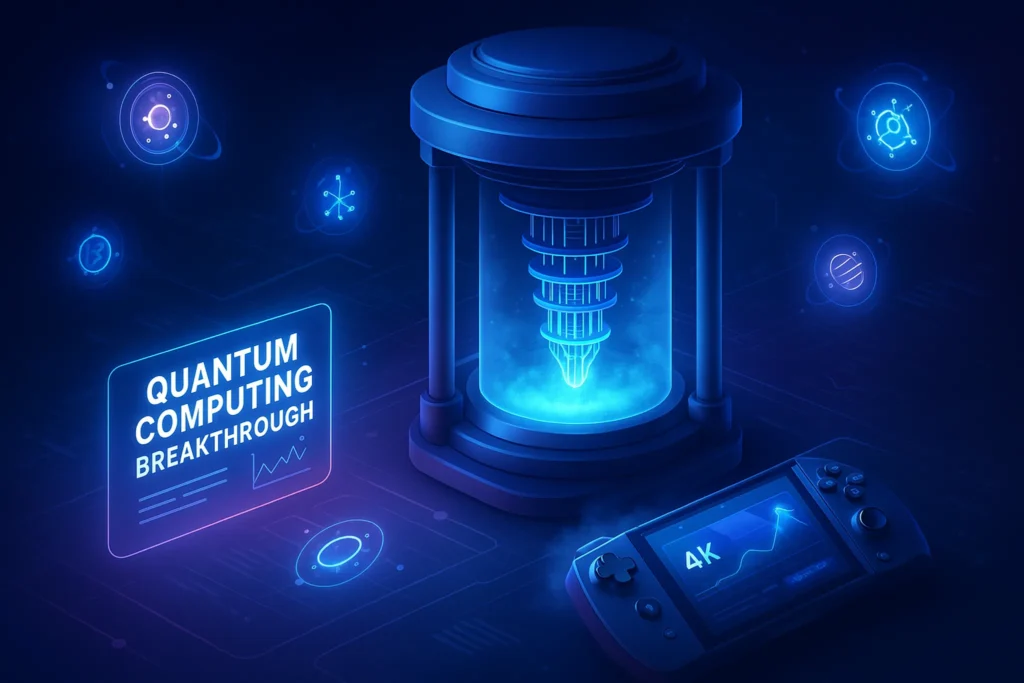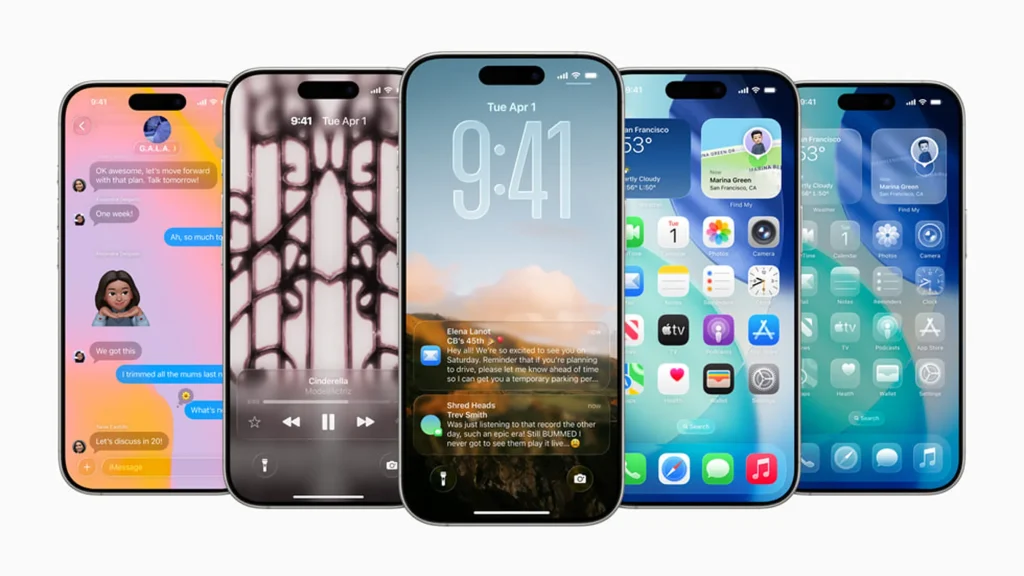-This post may contain affiliate links. If you click on one and make a purchase, I may earn a small commission at no extra cost to you.-
🔍 Introduction
2025 is shaping up to be a defining year for quantum computing—where long-theorized possibilities are turning into concrete progress. With systems reaching over 4,000 qubits, marks of quantum supremacy emerging again, and novel qubit architectures proving more reliable, the field is transitioning from experimental to genuinely groundbreaking. This article explores the new milestones, clarifies what they mean for tech, and asks–are we truly at the cusp of a quantum leap?
🧠 What’s New in 2025: Qubits, Chips, and Supremacy
After years of steadily climbing qubit counts, 2025 delivered some headline-grabbing breakthroughs:
-
IBM Flamingo & modular stack: IBM revealed plans to reach 4,000 qubits by interconnecting smaller chips like Flamingo and Kookaburra—a foundational move toward scalable systems.
-
Google Willow chip (105 qubits): This superconducting processor demonstrated below-threshold error correction, reducing noise as it scaled. A random-circuit task was solved in five minutes—an estimated 10²⁵ years for classical supercomputers.
-
D-Wave’s Advantage² annealer: A peer-reviewed study in Science claimed quantum supremacy on a real-world materials simulation problem, completing a computation in minutes that would take a classical supercomputer nearly a million years.
-
Microsoft Majorana 1: A topological-qubit prototype built with exotic materials claimed to be the first practical step toward fault-tolerant qubits—expected to scale to millions on a single chip.
-
Oxford’s precision record: Famed physicists achieved an unprecedented low error rate—one error per 6.7 million quantum gate operations—pushing reliability into useful territory.
-
Neutral-atom systems: Companies like Atom Computing and Quantinuum simulated complex quantum systems with 48–1121 qubits, showcasing diverse hardware approaches.
🌐 Why These Developments Matter
Quantum computing has long existed on the edge of possibility—promising to revolutionize industries, but always “a few years away.” In 2025, however, the field has started to bridge the gap between theory and utility, marking a genuine turning point. These breakthroughs are not just technical marvels; they signal the emergence of a new computational paradigm that could redefine how we solve complex problems.
Take IBM’s modular architecture: instead of chasing ever-larger monolithic chips, IBM is focusing on connecting smaller quantum modules, such as Flamingo and Kookaburra, to scale up logically rather than physically. This is a major shift—modularity mirrors how classical supercomputers operate, making quantum expansion more feasible and less error-prone. It also brings us closer to real-world integration, as businesses could begin leveraging quantum capabilities in specific workflows without waiting for the “perfect” universal quantum computer.
Then there’s Google’s Willow chip, which not only boosts qubit count but introduces an entirely new error-scaling mechanism. Traditionally, adding more qubits increases the chance of system collapse due to decoherence. Willow defies this trend by actually reducing noise as it scales, a potential breakthrough in quantum error correction that has haunted researchers for decades.
Another milestone: D-Wave’s recent claim of quantum supremacy in solving a materials science problem. While “supremacy” has been a controversial term in the past, this time it’s grounded in a task with clear commercial relevance. That shift—from synthetic benchmarks to practical, industry-specific outcomes—indicates quantum computers may finally be ready to move out of the lab and into real-world problem-solving environments.
And Microsoft’s announcement of Majorana 1 could be one of the most consequential developments yet. Topological qubits, which the chip is based on, promise inherent fault-tolerance. If this technology matures, it could drastically reduce the need for complex error correction algorithms, making quantum systems smaller, more efficient, and commercially viable on a broader scale.
These developments matter not just because they push the boundaries of what quantum machines can do—but because they suggest that quantum computing is finally becoming practical. No longer an exotic branch of theoretical physics, it’s now a serious contender for real-world disruption across cybersecurity, medicine, logistics, and more.
From Theory to Practice
IBM’s modular design brings quantum utility from megascale vision to realistic growth, helping developers work with incrementally improving platforms .
Real Quantum Advantage
Google’s Willow and D-Wave both claim performance edges—whether in raw speed or real-world simulation—suggesting quantum tools are approaching genuine utility .
Pioneering Qubit Tech
Microsoft’s Majorana devices demonstrate a new qubit paradigm—topological qubits promise built-in error resistance, potentially rewriting the rulebook for large-scale quantum machines.
Precision and Practicality
Oxford’s record-low error gates show that qubits are maturing—creating reliability levels needed for fault tolerance and real-world applications .
🏗️ Scaling Up: Modular Designs and Fault‑Tolerance Roadmaps
The dream of a “big quantum computer” demands more than just cramming qubits onto a single chip. In fact, traditional monolithic architectures hit fundamental barriers in coherence and controllability. In response, companies like IBM have pivoted toward modular quantum computing in 2025—a shift that mirrors the evolution of classical supercomputers and marks a critical milestone in quantum scalability.
IBM’s roadmap illustrates this new philosophy. Instead of creating ever-larger single chips, the company is designing separate processors (Flamingo, Kookaburra) and linking them together with quantum couplers. The Flamingo chip, with around 1,386 qubits, assembles three modules into a 4,158‑qubit system via microwave couplers and cryogenic interconnects. These coupling technologies serve as the quantum equivalent of network nodes—enabling each chip to behave as part of a seamlessly integrated whole.
This modular system is more than hardware ingenuity—it fundamentally transforms path to fault-tolerance. The architecture relies on a hybrid stack: IBM is coupling modular hardware with next-generation quantum error-correction techniques, such as their bicycled LDPC codes and on-chip decoders on FPGAs or ASICs. These decoding frameworks dramatically reduce error-correction overhead, bringing the first operational Starling system into view by 2029.
By combining modular architecture with powerful LDPC-based error correction, IBM is establishing a practical foundation for quantum systems that can run millions of gates on hundreds of logical qubits—a pivotal step toward real-world utility.
💥 Real-World Supremacy: When Quantum Solves Actual Problems
The term “quantum supremacy” once described an abstract, synthetic challenge. In 2025, however, D-Wave repurposed it to highlight real-world gains. Using their Advantage² annealer, they simulated magnetic material properties—a task classical supercomputers would need nearly one million years and a comparable amount of energy to perform. D-Wave’s system completed it in mere minutes, a legitimately practical application of quantum advantage.
Granted, critics note that classical optimizations may eventually narrow the gap . Yet this milestone should not be underestimated: it symbolically—and practically—shifts quantum from theoretical to industrial, unlocking paths in material science, pharmaceuticals, and high-energy physics that were previously unreachable.
Furthermore, the fact that D-Wave’s system is publicly accessible through Leap quantum cloud services underscores a broader shift: quantum hardware is no longer just in labs—it’s becoming a dependable business-grade resource for early commercial use.
Quantum progress isn’t just academic—it could transform global industries:
-
Breaking encryption: Though breakthroughs like Willow raise theoretical threats to RSA/ECC systems, experts say practical decryption is still 5–10 years away.
-
Drug discovery & materials: Simulations like D-Wave’s achievement mark real steps toward solving complex chemical structures and accelerating material innovation.
-
Industrial optimization: Quantum-enhanced processes—from logistics to finance and defense—are testing scenarios today thanks to low-error gates and improved qubit scale.
🧭 What Comes Next — From Milestones to Mainstream
The roadmap ahead is clear: quantum technology is stepping into the limelight, but widespread adoption requires solving four intertwined challenges:
-
Error Correction and Maintenance
Modular chips lose their effectiveness without robust error correction. IBM’s integration of LDPC codes and near-term implementation of intelligent decoders show real progress, but large-scale fault tolerance remains the gold standard of the next few years. -
Commercial Integration
Quantum tools like D-Wave’s annealer are entering practical workflows now, but broader adoption will hinge on seamless integration into cloud and HPC ecosystems. Companies that refine user-friendly APIs and domain-specific algorithms will lead the charge. -
Global Competition and Standards
Modular U.S.-led progress contrasts with China’s rapid systems—such as Zuchongzhi—but there’s still no global standard. Efforts toward export controls, EU rule frameworks, and shared protocols will influence the trajectory of partnership and competition. -
Quantum Literacy and Infrastructure
Real utility demands not just tech breakthroughs but education. As public cloud access scales, so must investments in developer tools, quantum-classical hybrid architectures, and education—so technical breakthroughs don’t go unused.
🏭 Key Players & Their Positioning
-
IBM is scaling modular platforms and rolling out its Heron 156-qubit chip globally via the Quantum System Two.
-
Google Quantum AI positions Willow as the most scalable logical qubit device to date—even as skeptics question its immediate utility.
-
D-Wave focuses on annealing advantages, showcasing profitability and real-world impact as it goes public.
-
Microsoft steps into topological qubits with Majorana 1 and partnerships in neutral-atom systems.
-
Atom Computing & Quantinuum supply high-qubit neutral-atom systems that balance scale and stability.
🧭 Challenges Remaining
Even as progress accelerates, critical obstacles must be overcome:
-
Error correction: Full fault tolerance still demands exponentially more affordable error rates, and Willow’s system, while promising, hasn’t yet shown large-scale gate implementation.
-
Scalable interconnects: IBM’s modular roadmap requires seamless linking of multiple processors—a technical and engineering hurdle.
-
Commercial viability: D-Wave’s supremacy via annealing is promising, but classical alternative algorithms have in some cases closed the gap.
-
Global competition & ethics: Chinese systems like Zuchongzhi challenge U.S. hegemony, while the UN designates 2025 as a Year of Quantum Science—signaling both collaboration and rivalry.
🔮 The Path Ahead: Where Quantum Goes From Here
Given current momentum, here’s what to expect next:
-
Mid-2020s: Scaling qubit systems above the 1,000 mark for simulations; more breakthroughs in error correction and modular architectures.
-
Late-2020s: Transition to hybrid quantum-classical systems solving real problems in finance, energy, and drug R&D.
-
2030+: Widespread commercial quantum services, real-time secure communication, and shifts in cybersecurity standards.
🧠 Nerd Verdict
The quantum revolution isn’t unfolding in isolation—it’s deeply entwined with the broader AI boom led by major tech players. Companies like Google and Microsoft aren’t just advancing AI models like Gemini and GPT—they’re also investing heavily in quantum infrastructure that could fuel next-generation AI systems. In fact, much of the urgency behind recent AI breakthroughs can be traced to the rising potential of quantum-enhanced computation. If you’re tracking how Big Tech is shaping the future through competing AI platforms and hardware innovation, you’ll want to explore our deep dive: Big Tech’s AI Arms Race: How Google, OpenAI, and Others Are Shaping 2025.
❓ FAQ
Q: Does Willow break encryption today?
Not yet—though Willow signals progress, cryptography remains safe for another 5–10 years.
Q: Is modular quantum computing here?
Yes, IBM’s System Two and processor link design are enabling scalable, modular quantum systems.
Q: What’s the real benefit of D-Wave’s supremacy?
Its annealing approach solves specific material problems already and is commercially used, though classical algorithms remain competitive.
Q: Is Microsoft’s Majorana 1 a game-changer?
Potentially—topological qubits might radically reduce error rates, but practical systems remain years away.
💬 Would You Bite?
Can you imagine a future where quantum computers solve real-world problems—like discovering new materials or optimizing global logistics—within your lifetime?
Share your thoughts—will quantum crack real problems soon, or is it still a long way off? 👇



